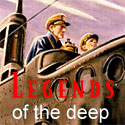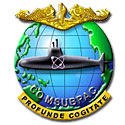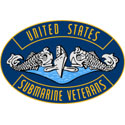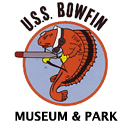A while back I had the opportunity to talk at length with former Wahoo crewman James Allen. Jim joined the boat in Pearl Harbor for her second war patrol. We began by discussing his commanding officer at the time, Captain Marvin Kennedy. Given some of the negative things written about him, I asked Jim about his impression of Kennedy.
“Kennedy was an elitist. Every morning he took a freshwater shower in the forward torpedo room while forbidding showers for the rest of the boat. It was very disconcerting for morale. He was very aloof. I only had two interactions with him the entire time I was aboard.”
Jim went on to describe the first encounter which occurred when he was heading forward to check the battery levels. This was done using a hydrometer to measure the specific gravity of each cell. The task required him to crawl across the top of the cells. As a result, he frequently came in contact with battery acid which ate holes in his dungarees. Jim trimmed the legs and arms of his dungarees to eliminate the holes. It was standard procedure at the time but decidedly non-regulation.
As he passed through the control room, Kennedy entered from forward. “At this point,” Jim said, “I made my first mistake. I said, ‘Good morning, Captain.’ Kennedy looked at me like I was a piece of meat on a hook. He turned to the Chief of the Boat, Pappy Rau, and said, ‘Rau, have this man change into proper clothes.’ After Kennedy continued on, Rau looked at me disgusted and said, ‘You heard the man.’”
Jim stood watch with CTM Russell “Pappy” Rau and Ken Whipp in the control room at the electrical panel – the dry side of control. Jim recalled, “Pappy Rau was easy to talk to and knew his stuff which gave confidence to the rest of enlisted men.”
Jim was standing nearby in control when an incident occurred between Rau and the boat’s Yeoman, Forest Sterling. Dick O’Kane had removed Sterling from the regular watch list so he could concentrate on typing the patrol report mimeograph stencils. While typing, Joe Vidick called him to go on his usual sonar watch. Sterling refused impolitely.
Thinking better of it, Sterling went to control to advise Rau he had been reassigned. Before he could get his second word out Rau slugged him hard, driving him into the air manifold. Sterling regrouped and glared at Rau who was ready to go another round. “I’m gonna report you,” Sterling said. Rau replied, “I’m counting on it.” Sterling retreated and the misunderstanding was soon sorted out.
Jim recalled, "When Rau gave an order he expected stuff done -- right then."
Continue Reading
“Kennedy was an elitist. Every morning he took a freshwater shower in the forward torpedo room while forbidding showers for the rest of the boat. It was very disconcerting for morale. He was very aloof. I only had two interactions with him the entire time I was aboard.”
Jim went on to describe the first encounter which occurred when he was heading forward to check the battery levels. This was done using a hydrometer to measure the specific gravity of each cell. The task required him to crawl across the top of the cells. As a result, he frequently came in contact with battery acid which ate holes in his dungarees. Jim trimmed the legs and arms of his dungarees to eliminate the holes. It was standard procedure at the time but decidedly non-regulation.
As he passed through the control room, Kennedy entered from forward. “At this point,” Jim said, “I made my first mistake. I said, ‘Good morning, Captain.’ Kennedy looked at me like I was a piece of meat on a hook. He turned to the Chief of the Boat, Pappy Rau, and said, ‘Rau, have this man change into proper clothes.’ After Kennedy continued on, Rau looked at me disgusted and said, ‘You heard the man.’”
Jim stood watch with CTM Russell “Pappy” Rau and Ken Whipp in the control room at the electrical panel – the dry side of control. Jim recalled, “Pappy Rau was easy to talk to and knew his stuff which gave confidence to the rest of enlisted men.”
Jim was standing nearby in control when an incident occurred between Rau and the boat’s Yeoman, Forest Sterling. Dick O’Kane had removed Sterling from the regular watch list so he could concentrate on typing the patrol report mimeograph stencils. While typing, Joe Vidick called him to go on his usual sonar watch. Sterling refused impolitely.
Thinking better of it, Sterling went to control to advise Rau he had been reassigned. Before he could get his second word out Rau slugged him hard, driving him into the air manifold. Sterling regrouped and glared at Rau who was ready to go another round. “I’m gonna report you,” Sterling said. Rau replied, “I’m counting on it.” Sterling retreated and the misunderstanding was soon sorted out.
Jim recalled, "When Rau gave an order he expected stuff done -- right then."







